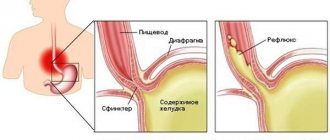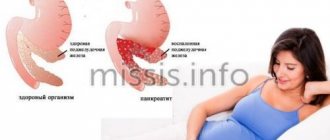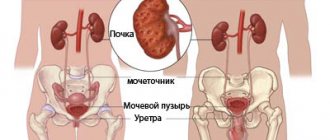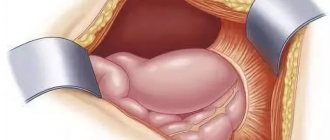Periodic or constant pain in the chest when swallowing can be a sign of many problems and diseases - from a cold to a foreign body in the human body. The main reason is a pathological process in the digestive system. Any problems with the gastrointestinal tract most often arise and develop unnoticed and practically asymptomatic. But if, when swallowing, it hurts in the middle of the chest or radiates to other areas, you cannot ignore it. Trying to relieve pain and self-medicating is not recommended. It is better to consult a general practitioner
who will determine the exact cause and prescribe the correct treatment. Everything should happen under the supervision of a specialist.
Chest pain when swallowing: causes
Painful discomfort can be associated with various disorders in the body. Pain when swallowing is caused by viruses and colds, allergies, foreign bodies in the throat or esophagus, as well as diseases of various systems and internal organs. If you experience pain while eating or swallowing, then most likely there are problems with the esophagus, and the pain radiates to the sternum. The problem may be associated with disturbances in the contractions of the esophagus, with the emergence and development of pathologies, with the passage of food into the stomach, with inflammation or erosion of the mucous membrane, etc. What do you need to remember? If, when swallowing food, pain appears in the chest area (on the left, right or in the middle), then this rarely indicates problems and diseases of the chest - more often there is a symptom of gastrointestinal tract pathologies, including oncological ones.
Treatment
Treating the underlying cause of chest pain while eating or drinking is the best way to relieve the symptom. But for ongoing symptoms, there are some strategies that can help reduce irritation in the esophagus. These include:
- eat less but often
- chew food thoroughly
- eat soft food
- avoid sour, spicy or minty foods
- avoiding caffeine and alcohol
- waiting several hours before lying down after eating
- to give up smoking
- avoiding allergens
- take the tablets with plenty of water and, if necessary, food to reduce the chance of irritation
People with acid reflux or GERD may also benefit from sleeping with their head slightly elevated.
Possible diseases
What led to the pain and how serious the problem is, only a specialist can say. Therefore, if it is difficult and painful for you to swallow, do not delay visiting a doctor, because you risk missing the onset of a serious illness and worsening your health condition.
Esophageal diverticula
Diverticulum is a dangerous disease that can lead to a large number of suppurations and ulcers in the neck and the development of pneumonia. It all starts with the fact that the walls of the esophagus are stretched due to the occurrence of hernial formations. They interfere with normal swallowing of food and cause severe pain. The first signs of the disease are bad breath, sore throat and further painful swallowing.
Esophagitis
This is an inflammatory process in the esophageal mucosa that causes pain when eating. Pain syndrome occurs in separate parts of the esophagus, or it hurts entirely. The intensity and nature of the pain resembles an attack of angina pectoris and responds with pain behind the sternum.
Esophagospasm
A disease of esophageal motility, in which painful sensations appear both when eating and drinking water, and at rest (for example, during sleep) or under severe stress when a person is worried. Pathology develops when the nerve plexuses are disrupted or when the mucous membrane is damaged.
Cardiospasm
Pathology develops when a narrowing and subsequent expansion occurs in the lower part of the esophagus. When the situation worsens, the patient develops anemia and vitamin deficiency, as well as constant belching and nausea.
Gastroesophageal reflux disease
This is a chronic disease that manifests itself in the form of hydrochloric acid from the stomach entering higher parts of the digestive tract. In this case, the mucous membrane of the esophagus is constantly injured, and the person experiences more and more pain when swallowing. The pathology is accompanied by a severe cough and constant sore throat. The disease can be recognized if heartburn torments every day for several hours a day and for several months in a row. If left untreated, the disease will lead to the development of ulcers and possibly esophageal cancer.
Risk factors
Sometimes it is not clear what causes pain when swallowing. But some conditions that affect the esophagus have similar risk factors. These include:
- Pressure on the esophagus
: Constant coughing, frequent vomiting, lifting heavy objects, or frequent straining during bowel movements puts pressure on the muscles of the esophagus. This may increase the risk of developing a hiatal hernia. - Medicines
: Medicines that irritate or relax the muscles of the esophagus may cause pain when swallowing. For example, benzodiazepines relax muscles, which allows acid to enter the esophagus and cause irritation. Nonsteroidal anti-inflammatory drugs such as aspirin can also irritate the esophagus, while opioids are a common cause of dysmotility problems. - Pregnancy
: Acid reflux is common during pregnancy and can lead to GERD. In addition, frequent vomiting as a result of morning sickness can cause esophagitis. - Obesity
: Increased body weight is a risk factor for hiatal hernia, acid reflux, and GERD. Losing weight helps relieve symptoms. - Smoking and alcohol
: Smoking, secondhand smoke, and alcohol can also irritate the esophagus and are risk factors for acid reflux, GERD, and esophageal cancer. - Family history
: Conditions such as EoE can run in families.
Esophageal injuries
If a patient comes to the doctor asking why there is pain in the middle of the chest when swallowing, then the doctor must determine the cause. This is often associated with trauma to the esophagus, which may be:
- received due to various types of damage: gunshots, stab wounds, incised wounds, etc.;
- associated with internal pathological processes: neoplasms, narrowing, expansion in different areas (neck, thoracic region, etc.);
- associated with various pathologies of body systems, for example, damage to large vessels;
- received due to damage during surgical treatment, for example, during intubation, neck injuries, etc.
The type and duration of treatment depends on the type of injury and the severity of the damage.
Etiology
As mentioned above, pain in the chest during swallowing is caused by disorders associated with the esophagus. It follows from this that the following pathologies of this organ will be provoking factors:
- spasm of the esophagus, which can be diffuse and segmental. In the first case, dysfunction of smooth muscles is observed throughout its entire length. The second situation is characterized by excessive contraction of the muscles of the esophagus in a certain area. This means that at some point the food will not be able to pass any further;
- hiatal hernia;
- achalasia cardia;
- GERD;
- perforation of the wall of this organ;
- injury to the esophagus by a foreign object entering it;
- spontaneous rupture of the esophagus - this can occur against the background of suppression of vomiting or sphincter dysfunction caused by severe alcohol intoxication or pathologies of the central nervous system;
- chemical or thermal burns of the mucous layer of the esophagus;
- the occurrence of peptic esophagitis;
- the formation of oncological, less often benign, neoplasms;
- ulcerative lesions of the esophagus;
- scar formation on the sphincter;
- esophageal dyskinesia;
- damage to the mucous layer of this organ by an erosive or inflammatory process
Esophageal dyskinesia
The pathogenesis of pain in the chest area is that the food bolus moves through the esophagus due to a certain coordination of the movements of the esophageal tube. If such an automatic process for the human body is disrupted for one of the above reasons, then food will pass through with some difficulty or accumulate in one of the departments of this organ. This, in turn, will lead to its stretching and, as a result, the occurrence of pain. In situations where such a disorder is a consequence of one or another illness, drinking a little water will not be enough to relieve the discomfort. Moreover, in some situations this can further increase pain.
Symptoms
The pathology has quite varied symptoms, which largely depend on the type of damage, causes, concomitant diseases and duration of the disease. The main symptoms include:
- bad breath, burning, heartburn, cough, shortness of breath, difficulty breathing;
- sharp pain (most often behind the sternum);
- low pressure;
- decreased appetite, weakened immune system, gastrointestinal problems;
- pale skin color, blue mucous membranes, etc.
The first and most obvious symptom is problems with swallowing.
Symptoms
In the vast majority of cases, pain when swallowing localized in the chest is the first clinical manifestation indicating the development of a particular disease.
The specificity of this symptom lies in its focus - very often people perceive pain in the sternum as a symptom of cardiovascular pathologies. In this case, patients seek help from a cardiologist and undergo unnecessary diagnostic measures. At this time, a completely different disease progresses in the body.
The most common symptoms that complement the clinical picture that it is painful for a person to swallow are:
- belching and heartburn;
- burning and discomfort in the chest area;
- irradiation of pain to the area between the shoulder blades and the heart. Several times less common is the spread of pain to the back and upper limbs, jaw and ears;
- disruption of the process of swallowing food ingredients - with minor damage to the esophagus, dysphagia is associated only with solid food, but as the situation worsens, even liquid cannot pass through the esophageal tube, which can lead to exhaustion;
- acquisition of a permanent character by the main feature and its significant strengthening in the process of food consumption;
- cough and sore throat;
- pathological redness of the face;
- increased gas formation and salivation;
- attacks of nausea and vomiting. Sometimes the presence of pathological impurities, for example, blood, may be observed in the vomit;
- stool disorder - most often patients complain of constipation, less often of diarrhea or alternation of similar manifestations;
- increased body temperature;
- prolonged fever;
- discomfort in the epigastric region;
- aversion to food - very often this happens in relation to fatty foods, meat and dairy products;
- shortness of breath - along with pain in the heart area forces people to consult not a gastroenterologist, but a cardiologist.
The above symptoms do not mean at all that the clinical picture will be limited only to such signs. Depending on the etiological factor, some of them may fade into the background.
Diagnostics
The doctor will determine which examinations will be needed during the initial consultation. To do this you need to see a therapist
who will give recommendations and directions, or you can immediately go to
a gastroenterologist
who will prescribe an endoscopy of the stomach and esophagus.
X-rays (with and without contrast agent), ultrasound
of certain internal organs, checking the functioning of the cardiovascular system and additional studies and tests (for each specific case) may also be prescribed.
Prevention and prognosis
To prevent pain when swallowing, in particular during eating, no specific preventive measures have been developed. However, people are advised to follow a number of simple general rules. These include:
- maintaining an active and healthy lifestyle;
- avoiding emotional and physical fatigue;
- drawing up a correct, balanced and enriched diet with all the substances necessary for the body;
- using only those medications prescribed by the attending physician - with strict adherence to the daily dosage and duration of therapy;
- if possible, avoid injury to the esophagus from the outside or foreign objects;
- undergo a full preventive examination at a medical institution several times a year with a mandatory visit to a gastroenterologist.
The outcome of chest pain when swallowing directly depends on the disease that provoked it. However, since they are a specific symptom that forces a person to see a doctor, treatment often begins in a timely manner, which gives a positive prognosis. However, we should not forget that each etiological factor has its own complications.









